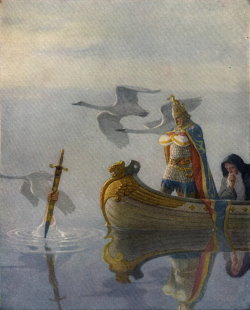
Royalty wearing samite robes.
Samite was a luxurious and heavy silk fabric worn in the Middle Ages. It was a twill - type weave, often including gold or silver thread. The word was derived c. 1300 from Old French samit.
By the later medieval period, the term samite was applied to any rich, heavy silk material which had a satin - like gloss,
indeed satin
began as a term for lustrous samite. Samite is still used in ecclesiastical robes, vestments, ornamental fabrics,
and interior decoration.
Fragments of samite have been discovered at many locations along the Silk Road, and are especially associated with Sassanid Persia.
Samite was arguably the most important
silk weave of Byzantium, and from the 9th century Byzantine silks entered Europe via the
Italian trading ports.
Vikings, connected through their direct trade routes with Constantinople, were buried in samite embroidered with silver - wound threads in the 10th century. Silk weaving itself was established in Lucca and Venice in the 12th and 13th centuries, and the statutes of the silk - weaving guilds in Venice specifically distinguished sammet weavers from weavers of other types of silk cloth.
The Crusades brought Europeans into direct contact with the Islamic world, and other sources of samite, as well as other Eastern luxuries.
At the time of the First Crusade, samite needed to be explained to a Western audience, as in the eyewitness Chanson d'Antioche
:
Very quickly he took a translator and a large dromedary loaded with silver cloth, called
samitein our language. He sent them to our fine, brave men...
The Fourth Crusade brought riches unknown in the West to the Frankish
crusaders who sacked Constantinople in 1204,
described by Villehardouin:
The booty gained was so great that none could tell you the end of it: gold and silver, and vessels and precious stones, and samite, and cloth of silk...
Samite was a royal textile. For those of royal blood there were robes and mantles of samite and cloth of gold.
Samite itself might be interwoven with threads wrapped in gold foil. It could be further enriched by
being over - embroidered: in Chrétien de Troyes' Perceval, the Story of the Grail
(1180s):
On the altar, I assure you, there lay a slain knight. Over him was spread a rich, dyed samite cloth, embroidered with many golden flowers, and before him burned a single candle, no more, no less.
In the wrong hands, samite could threaten the outward marks of social stability; samite was specified among the forbidden luxuries denied the urban middle classes in sumptuary laws by the court of René of Anjou about 1470:
In cities mercantile governments outlawed crowns, trains, cloth of samite and precious metals, ermine trims, and other pretensions of aristocratic fashion.

Lady of the Lake
As the premier luxury textile of the Middle Ages, samite has long been associated with Arthurian literature.
In the dramatic and eerie manifestation of the Holy Grail in Arthur's court in the Romance Queste del Saint Graal
,
the Grail appeared, covered with a samite cloth, hung in the air a moment, and disappeared.
It was famously referred to in the Idylls of the King
cycle of poems by Alfred, Lord Tennyson.
There the Lady of the Lake, described in the cycle only by the same line, repeated in four different places:
Clothed in white samite, mystic, wonderful
gives Arthur his sword Excalibur and then in the The Passing of Arthur catches it when it is flung into the lake as he lies dying. This appearance was referenced, too, in the film Excalibur and even burlesqued in Monty Python and the Holy Grail.
